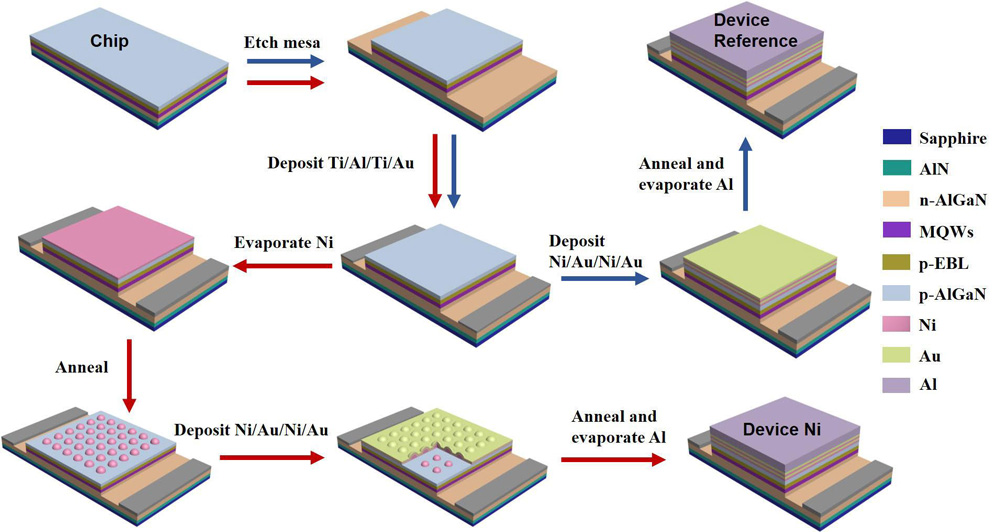News: LEDs
8 November 2023
Nickel nanoparticle lift to p-GaN-free deep-UV LEDs
Hebei University of Technology and Advanced Ultraviolet Optoelectronics Company Ltd in China have reported the use of self-assembled nickel (Ni) nanoparticles to improve the performance of deep ultraviolet (DUV, wavelength less than 300nm) light-emitting diodes (LEDs) that do not contain DUV-absorbing gallium nitride (GaN) [Tong Jia et al, IEEE Transactions on Electron Devices, published online 27 October 2023].
DUV LEDs are being developed for a wide range of applications such as disinfection, air/water purification, indoor plant growth, and phototherapy. Presently, DUV is mostly generated using mercury lamps, which are bulky, have low efficiency and lifetime, and release poisonous vapor when broken. It is hoped that successful LED development will address each of these drawbacks. The present efficiency for AlGaN DUV LEDs is less than 20% at 280nm wavelength.
P-type GaN is often used as a hole injector into DUV LEDs constructed otherwise from aluminium gallium nitride (AlGaN) alloys. The alternative of using p-AlGaN contacts suffers from lower hole injection efficiency, but are more transparent to DUV. Such p-GaN-free DUV LEDs have been achieved, and ways to improve the various efficiencies that make up the overall energy efficiency have begun to be explored extensively.
The Hebei researchers’ device structure with Ni nanoparticles (Device Ni) improves the contact resistance between the metal and AlGaN on the p-side of the LED, and also improves the light-extraction efficiency by reducing the total internal reflection arising from the high refractive index contrast between the AlGaN and other materials of the LED and air. Both these factors reduce the chip temperature, adding to the improvement in performance.
The team explains: “We think that two factors contribute to the lower chip temperature of Device Ni. First, the nanoparticle array causes more photons to be scattered out of the device. Hence, fewer photons are absorbed by the device and, thus, less heat is generated. Second, as has been previously discussed, the presence of Ni nanoparticles reduces ohmic contact resistance in Device Ni, thereby decreasing heat production under identical current conditions, which results in an improved self-heating effect.”

Figure 1: MOCVD epitaxy structure for DUV LEDs.
The material for the DUV LEDs was grown using metal-organic chemical vapor deposition (MOCVD) on c-plane sapphire (Figure 1). The researchers processed the material into two device types: a reference, and a device enhanced with Ni nanoparticles (Figure 2).
The first fabrications steps, common to both devices, were to etch mesas with inductively coupled plasma, and then to deposit and anneal titanium/aluminium/titanium/gold (Ti/Al/Ti/Au) for the n-electrode.

Figure 2: Process flowcharts for Ni nanoparticle device and reference.
The reference device was completed by depositing and annealing nickel/gold/nickel/gold (Ni/Au/Ni/Au) for the p-electrode, and then evaporating a thick aluminium layer for the contact pads.
The Ni device process preceded these final steps by first depositing 2nm Ni, followed by 2 minutes annealing in nitrogen at 600°C, forming Ni nanoparticles. According to atomic force microscopy (AFM), the nanoparticles were on average 75nm high and 300nm in diameter with around 50% fill factor.
After these processes the sapphire substrate was thinned down to 250μm with a view to chip singulation and encapsulation processing.
In electrical testing the researchers found that the Ni nanoparticle layer reduced the contact resistance between the p-AlGaN and NiAu electrode, enabling higher current injection into the device for a given forward voltage: 6V for 100mA, compared with 7V for the reference device to achieve the same injection current.
The researchers suggest that one effect of the Ni nanoparticles is to relieve thermal stress so that the subsequent Ni layer does not form clusters. Without the nanoparticles, the first Ni layer forms clusters during annealing, exposing parts of the overlying Au film, which then makes contact with the p-AlGaN.
The researchers comment: “It is difficult for Au/p-AlGaN interface to form ohmic contact. We infer that when Ni nanoparticles are embedded between NiAu/p-AlGaN, the thermal stress can be effectively relaxed. As a result, the Ni layer of NiAu on the Ni nanoparticles will remain intact and not transfer into clusters. Thus, the p-AlGaN is still fully covered with a Ni film after annealing, which facilitates superior p-type ohmic contact for Device Ni.”

Figure 3: (a) Optical power and wall-plug efficiency (WPE) versus injection current for Ni and reference devices. (b) Peak wavelength versus injection current.
The light output power reached 18mW at 200mA injection for the DUV LED with Ni nanoparticles, compared with 15.6mW for the reference device (Figure 3). The team comments: “Despite the fact that Ni has a high absorption rate for DUV light, Ni nanoparticles can also serve as scattering centers, leading to an improvement in optical power.”
Both devices suffer from ‘roll-over’ from increasing to decreasing light output power with increasing current injection. The researchers attribute this to self-heating, which degrades the internal quantum efficiency (IQE). The peak in output power occurs at a higher current in the Ni nanoparticle LED, indicating a reduced self-heating effect compared to the reference. Further indications of reduced self-heating was a reduced wavelength red-shift with increasing current, and a shorter wavelength for a given current, compared with the reference. At 200mA, the wall-plug efficiency (WPE) for the Ni device was 1.3%, compared with 1% for the reference.
The researchers also performed two-dimensional finite-difference time-domain (2D FDTD) simulations of the Ni and reference device structures, which suggested that the light extraction efficiency would increase if the Ni nanoparticle diameter were reduced to 120nm with a 600nm period, reducing the fill factor.
The team also reports lifetime studies up to 170 hours. The Ni device showed a slower deterioration in light output power. The reduced self-heating results in a lower chip temperature and hence longer life performance.
Deep ultraviolet LEDS DUV AlGaN GaN MOCVD Nickel nanoparticle
https://doi.org/10.1109/TED.2023.3325422
The author Mike Cooke is a freelance technology journalist who has worked in the semiconductor and advanced technology sectors since 1997.









